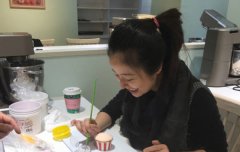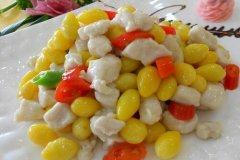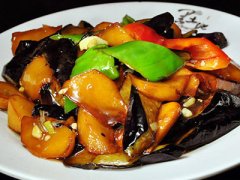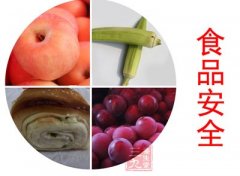舌尖上的中国第一季 第二集主食的故事 英文解说+中英文本(2)
老黄把家安在窑洞里,这种中国黄土高原最古老的居住形式,可以追溯到4000多年前。一位农民辛勤劳作一生,最基本的愿望就是修建几孔窑洞,有了窑,娶了妻,才算成家立业。
Huang's home, a cave house, is the most traditional dwelling format on the loess plateau in China. It has a history of over 4,000 years. For the hardworking farmers here, their basic wish is to renovate a cave into a home and marry a wife. That's how a life gets complete.
老黄和老伴一次做700个黄馍馍,上碾、揉面、发酵前后要花3天时间。两个人从凌晨3点钟开始,一直要忙到晚上9点。老黄的馍馍做得实在,人也实在,一个一块钱,从不还价。在一年中最寒冷的两个月里,老黄能卖出15000个黄馍馍,刨去成本,一个冬天他的实际收入大约是8000元。
Huang and his wife can make 700 buns every time. Grinding up, kneading and fermentation, the whole process takes 3 days. The couple works from 3 a.m. through 9 p.m. Huang's buns are good-tasting. And Huang is an honest businessman. One yuan for each bun, no bargain. In the coldest two months of a year, Huang can sell 15,000 buns. Taking into account the cost, he can earn 8,000 yuan in a winter.
老黄在这里养育了一儿一女。现在,孩子们都已经把家安在城市里,不再与土地打交道。然而,老黄不愿意离开,住着自己的窑洞,吃住自己种的粮食,老黄自足而踏实。
Huang has a son and a daughter. Both have settled down in the city. They no longer work on the farmland. But Huang doesn't want to leave. Living in his cave house and eating the food he plants, Huang feels satisfied with his wife.
千百年来,中国人从五谷中获得温饱,而这种碳水化合物营造出的满足感,正是亿万个像老黄这样在土地上辛勤劳作的农民提供的。
For thousands of years, Chinese people gain food and clothing from the five cereals. The feel of satisfaction brought by these carbohydrates is just provided by millions of hardworking farmers like Huang.
秋季,辽阔的中国北方,成熟的小麦决定了大地的基本色。小麦,从河西走廊传入到中 原,因为营养丰富,经过4000多年的本土化历程,成为中国北方栽培面积最广泛的农作物。这种原产于西亚的优良物种,已经成为中国人最重要的主食。
In autumn, the ripe wheat decides the basic color of the land in North China. Wheat was introduced into the Central Plains through the Hosi Corridor. As it contains rich nutrition, it has been the most vastly planted crop in North China after a localization process of over 4,000 years. This species originated from West Asia and has become the most important staple food for the Chinese.
将小麦面粉发酵后,在特制的火坑中烤熟。这种圆形面饼,含水份少,极耐贮藏,是维吾尔家庭常年必备的主食。
After the wheat flour ferments, people bake them in a specially-designed fire pit. This type of round pancake contains little water and can be preserved for a long time. They're the indispensable staple food for Uyghur families in all seasons.
新疆库车,人们用享受美食的方式来庆贺古尔邦节。馕是维吾尔族人最喜欢的主食。馕的叫法出自古波斯语,已有2000多年的历史。
In Kuqa, Xinjiang, people celebrate the Corban Festival with delicacies. Naan is the most favorite staple food for Uyghur people. The name originated from ancient Persian and has a history of over 2,000 years.
馒头最早出现的时候,名字叫炊饼也叫 蒸饼,是中原地区最受欢迎的主食。只有中国人的祖先从水煮食物的原理中获得灵感,并使中国成为最早用蒸汽烹饪的国家。
When they first emerged, steamed buns were called Chui cakes and steamed cakes. They are the most popular staple food in the Central Plains. Ancient Chinese people were inspired by the water boiling food theory. They made China the earliest country to cook with steam.
中国的五谷,始终是一个变化中的概念。大约两千年前,五谷的排序为稻、黍、稷、麦、菽,而今天,中国粮食产量的前三名已经变成稻谷、小麦和玉米。但是无论如何变化,都无法动摇稻米在五谷中的首席地位。
Five cereals in China have always been a changing concept. Around 2,000 years ago, the five cereals were namely rice, broomcorn millet, millet, wheat, and beans. But today, the three grains that rank top in terms of their production volumes are rice, wheat and corn. No matter how things have changed, the leading status of rice remains unchanged.
地扪在侗语里的意思是泉水之源。地处清水江源头的地扪村,一年中阴雨天居多。吴顺玉正在自家的禾仓里取米。在这个潮湿的环境里,禾仓对于稻米的储藏起着至关重要的作用。木制吊脚瓦木结构的禾仓建在水上,可以防火、防鼠、防蚁虫。当地最古老的禾仓,已有300年历史。
In the Dong language, Dimen means the origin of spring. Dimen Village sits at the origin of Qingshui River. It mostly rains throughout a year. Wu Shunyu is fetching rice from their own barn. Barn plays a vital role in the storage of rice. The barn of tile and wood structure was built above the water to prevent fire, mice and insects. The most ancient barn here has a history of 300 years.
吴顺玉家在禾仓里储藏的是没有脱壳的稻谷,这能长时间保持稻米新鲜的口感。今天取的米要当做礼物,送到村头同族的一户人家。在地扪,生产完的妇女为孩子过满月那天,婆家人会把结婚时置办的彩礼送到娘家来,新家庭成立的仪式才算最后完成。同族的女眷们也会挑篮提篓,她们还在新米上放上鸡蛋,表示对新生命诞生最诚心的祝福。
The rice Wu Shunyu has fetched is with shells. The fresh taste of rice can be preserved with the shells. The rice Wu fetched today would be presented as a gift to a family in their village. In Dimen, after a woman gives birth and her baby reaches the age of one month, her parents-in-law would send her the betrothal gifts. That marks the official formation of a new family. Other women in the village would also send baskets with new rice and eggs. That represents the most sincere blesses for the newly-born.










